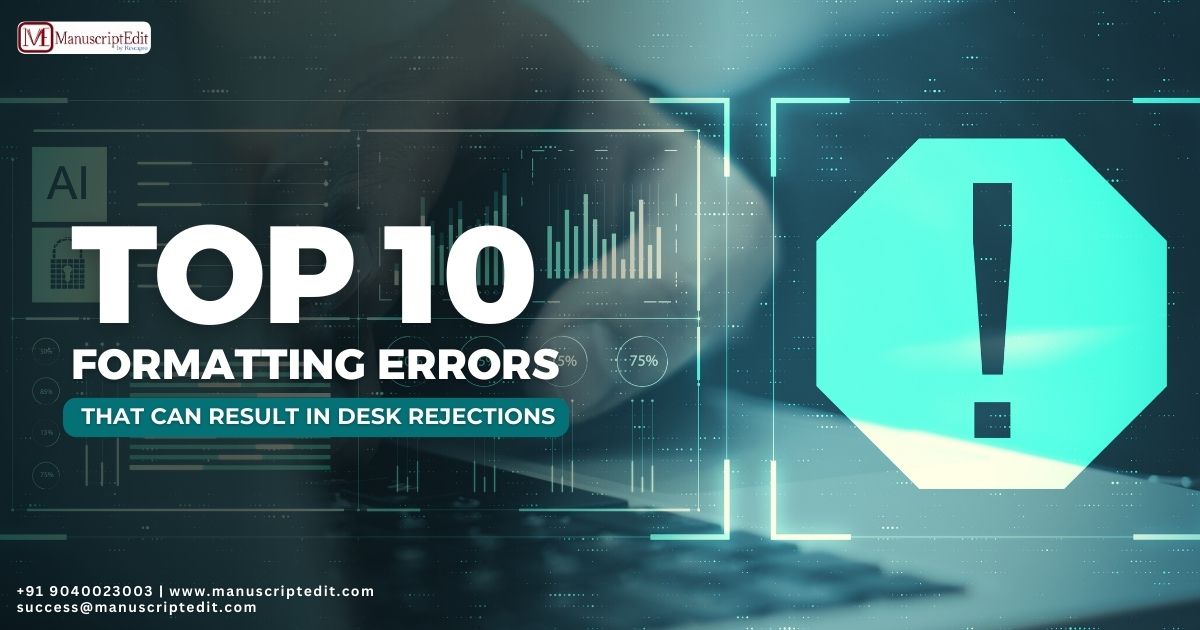|
Getting your Trinity Audio player ready...
|
Sending your research paper to a journal is a significant step. But before the editor even gets to read your manuscript there is one thing that can lead to rejection —formatting errors. These crucial errors can result in a desk rejection, i.e., your paper is rejected without being sent out for peer review.

Let’s run through the top 10 formatting errors researchers tend to commit.
Table of Contents
1. Not Adhering to Journal Guidelines
- Each journal has specific guidelines. Not abiding by them is a turn-off for editors.
- Omitting parts such as abstract or conclusion.
- Incorrect structure (e.g., Results before Methods).
- Providing a.doc file when only.pdf is accepted.
- Going over the Word or page limit.
Tip: Read and download the journal’s “Instructions for Authors” beforehand.
2. Incomplete or Incorrect Referencing
- Referencing can be tedious, but it matters.
- Getting the wrong style (APA format when the journal uses IEEE, etc.).
- Inconsistent referencing in your list of references.
- DOIs or web links omitted.
- Citing in-text references that don’t appear in your reference list (or vice versa).
Tip: Use citation tools like Zotero, EndNote, or Mendeley to keep you consistent.
3. Figures and Tables Improperly Formatted
Tables and figures contribute to telling your tale. But if they’re obscure, they will harm your paper.
- Low-quality or blurry pictures.
- Inadequate or unreadable captions.
- Failing to put figures where needed.
- Utilizing color when grayscale is needed.
Tip: Be sure to verify image resolution and adhere to the journal’s visual requirements.
4. Unorganized Formatted Abstract and Keywords
- Maintain word count as asked by the journal
- No keywords or excessive keywords.
- Not following a formal structure (if the journal requires one).
Tip: Make the abstract brief, and choose solid keywords that reflect your subject.
5. Inaccurate or Omitted Author Information
- This is easy, but most get it wrong.
- Using initials instead of full names.
- Omitting author affiliations.
- Lacking the email of the corresponding author.
Tip: Review the author section carefully before submission.
6. Incorrect Application of Headings and Subheadings
- Clear headings guide readers through your paper.
- Hopping between heading levels (e.g., H1 to H3).
- Not following the journal’s preferred style (bold, italics, numbering).
- Blending formats in the same section.
Tip: Follow a simple, logical heading hierarchy.
7. Non-Standard Language Formatting
- Language counts. Errors make your paper appear amateur.
- Using UK English when the journal prefers US English.
- Grammar and spelling errors.
- Ambiguous abbreviations or inconsistent terminology.
Tip: Use software such as Grammarly and have a colleague check your paper.
8. Unapproved Use of Special Characters or Equations
- Equations and symbols should be readable and accurate.
- Utilizing characters that don’t appear well.
- Failing to utilize the appropriate tools (e.g., Word’s equation editor vs. LaTeX).
Tip: Use standard formatting tools and preview your submission.
9. Cover Letter Errors
- A poor cover letter can damage your chances.
- Too vague or cut and pasted from the web.
- Failing to explain why your paper is suitable for the journal.
- Missing conflict of interest or funding information.
- AI driven cover letters with zero or limited human inputs.
Tip: Write a brief, journal-specific cover letter. Stay professional.
10. Issues with Supplementary Materials
- Some material should go into supplementary files. But they require attention as well.
- Omitting to add them.
- Incorrect labels or file names.
- Failing to refer to them in your primary manuscript.
Tip: Cite all supplementary files clearly and mention them correctly in your paper.
Final Thoughts
Formatting can appear insignificant, but it can significantly impact the reception of your paper. If your submission does not adhere to guidelines, you may get rejected without seeing your research.
Double-check your format before hitting the “Submit” button to prevent desk rejection. Also, obey the journal’s guidelines, use plain tools, and always proofread.
A professionally formatted paper indicates professionalism—and that’s an excellent first impression.
Go Submission-Ready with ManuscriptEdit
Avoid clear of formatting errors and provide your research with the professional edge it needs through ManuscriptEdit. Our premium services include:
Entry-Level & Advanced Formatting
Journal-Specific Reference & Citation Formatting
Alignment of Figures, Tables & Graphs
Journal Submission-Ready Packages
Leave the formatting to us—so you can concentrate on the research.
Submit your manuscript now at ManuscriptEdit.com.
Your research needs the spotlight. Let ManuscriptEdit make it happen.



